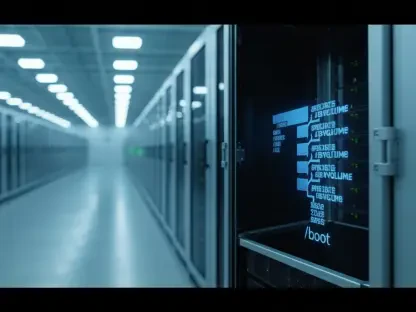In an era marked by ever-evolving cyber threats, traditional security measures that organizations have long relied on are proving inadequate for today’s digital landscape. The persistent increase in data volume and complexity, coupled with the need for more dynamic and transparent solutions, has prompted a shift in cybersecurity strategies. Open-source extended detection and response (XDR) tools have emerged as the vanguard of this transformation, offering a more transparent, adaptable approach to combating cyber threats. These solutions present a promising alternative to proprietary systems, providing security teams with the flexibility to refine detection strategies in alignment with specific organizational needs.
The Challenges of Traditional Cybersecurity Approaches
Overwhelming Data Volume
Security teams face a relentless onslaught of information in today’s fast-paced digital environment, requiring immediate attention. The strain of processing an overwhelming volume of data, including endpoint telemetry, network traffic, cloud logs, and identity signals, has intensified challenges for security operation centers (SOCs). Recent reports highlight that, weekly, an average SOC might receive up to 500 alerts necessitating further inspection. The high volume can lead to alert fatigue, where security personnel are flooded with notifications, often of low priority. Consequently, this state of affairs can result in crucial alerts getting disregarded, undermining the cybersecurity efforts in place to protect organizations.
Alert fatigue isn’t merely a minor inconvenience; it’s a significant risk that diminishes responsiveness to genuine threats. The complexity is compounded by the need to separate meaningful alerts from false positives, determining which ones warrant action. Traditional approaches that prioritize visibility without context fail to address these challenges effectively, leaving SOC teams dealing not only with operational issues but also misalignment with organizational goals. As boards intensify their scrutiny and regulatory needs evolve, these challenges underscore the urgent need for more refined solutions that offer not just improved visibility but actionable insights tailored to an organization’s unique context.
Lack of Contextual Insight
Traditional cybersecurity platforms often operate as “black boxes,” offering little transparency into the detection logic and processes involved. The absence of contextual information regarding alerts is a significant flaw, limiting a security team’s capacity to understand and prioritize threats accurately. Opaque detection methodologies and rigid reporting formats not only obscure vital threat data but also pose the risk of vendor lock-in, where organizations are tethered to specific products that may not align with their specific risk profiles. This scenario creates inefficiencies and blocks the adoption of more tailored, effective security tactics.
Beyond the immediate operational hurdles, this lack of insight and adaptability contributes to broader strategic challenges. Proprietary systems often come with pre-set configurations that can’t easily accommodate the specific security needs of different sectors. This inflexibility limits an organization’s ability to adjust detection and response strategies to their operational environment. Moreover, the disconnect between security teams’ operational activities and strategic organizational goals can hinder broader accountability and alignment across departments, complicating efforts to build coherent and comprehensive cybersecurity frameworks that meet both current needs and anticipate future threats.
Embracing Open-Source XDR Solutions
Transparency and Flexibility
The appeal of open-source XDR tools lies in their inherent transparency and flexibility, a stark contrast to traditional “black-box” systems. These solutions provide security teams with full access to detection logic and offer customization possibilities that allow for precise tuning according to an organization’s unique requirements. Open-source XDR solutions don’t just support better adaptability; they empower organizations with the capacity to modify and enhance detection strategies dynamically, accommodating current and emerging threats more effectively. This empowers teams to mold security defenses in a way that resonates with the broader organizational strategy.
Customizing security frameworks is crucial in an era where security threats are not only more frequent but also increasingly sophisticated. Open-source solutions allow for greater visibility into internal security processes, which can optimize resource allocation according to organizational priorities. As threats become more sophisticated, the ability to swiftly adapt detection rules and response strategies positions organizations to remain resilient against complex cyberattacks. This adaptability extends to not only improving the efficacy of security measures but also offering improved confidence in compliance with legal and regulatory demands, ensuring organizations not only protect their data but also meet legislative standards.
Support from Public Sector
The push for open-source XDR adoption has garnered significant validation from public sector authorities, underscoring its growing relevance and acceptance. In the U.S., key agencies such as the Office of Management and Budget (OMB) and the Cybersecurity and Infrastructure Security Agency (CISA) have emphasized the importance of open-source components in securing federal infrastructures. These endorsements speak to the model’s transparency and flexibility as pillars in crafting robust cybersecurity frameworks. Such guidance not only standardizes best practices across government entities but also signals to the private sector the immense advantages of open-source cybersecurity solutions.
Public sector initiatives increasingly advocate for transparency and collaborative development cycles, reflecting a significant shift from past preferences for proprietary solutions. The endorsement from bodies like OMB and CISA demonstrates a move towards principles of open development environments that foster stronger security postures. Their preference for open-source software aligns with wider trends for transparency in government technology procurement, emphasizing that true security relies on community contributions. This groundswell of public sector support aligns internal organizational security strategies with broader industry frameworks, advocating a “secure by default” approach that prioritizes open collaboration and cross-sector partnerships.
The Community Advantage in Open-Source Security
Collaborative Problem-Solving
Community-driven development serves as one of the pillars of open-source security, offering advantages that proprietary systems simply can’t match. By harnessing insights and real-time feedback from a global community of developers and security professionals, open-source XDR solutions stay ahead of the curve in addressing emerging threats. This collaborative effort ensures collective problem-solving, where solutions are continuously fine-tuned as new vulnerabilities arise. Collective, real-time improvements foster exceptional agility in the face of evolving threat landscapes, enabling faster response times that proprietary systems struggle to achieve.
The network effect inherent in open-source communities acts as a powerful force multiplier, giving organizations access to broad expertise and rapid innovation. Contributors across the globe continually update frameworks to address vulnerabilities and engineer better solutions, propelling security models that are more responsive and proactive. This communal approach reduces the reliance on single-vendor updates and allows organizations to deploy customized solutions more swiftly as threats change. Such collaboration translates into substantial benefits, enhancing threat detection capabilities while promoting a culture of learning and adaptability essential in modern cybersecurity practices.
Agility and Adaptability
The rapid adaptability afforded by open-source solutions shines as a key differentiator in cybersecurity frameworks, enabling organizations to craft tailored responses to specific threats swiftly. This adaptability ensures that security measures are not just reactive but predictive, aligning security strategies with dynamic operational environments. An agile development cycle supported by a global community turns the traditional software update model on its head, creating a cybersecurity paradigm where swift iterations and constant improvement become the norm. This not only aligns security with organizational objectives but also enhances operational resilience at all levels.
The decentralized nature of open-source contributions provides organizations with unparalleled adaptability, transforming challenges into innovative solutions built on collective intelligence. Agility in response is critical in today’s threat landscape, where new vulnerabilities can emerge at a breakneck pace. By adopting and adapting open-source XDR solutions, organizations gain robust security that evolves alongside shifting threats, ultimately driving superior performance in security protocols. This agility reflects an essential evolution in cybersecurity, where flexible, community-powered solutions give organizations the tools to anticipate, manage, and mitigate risks effectively, setting new standards in resilience.
Transforming Cybersecurity Landscape
Future Considerations for Open-Source Adoption
The transformation ushered in by open-source XDR systems signifies more than just an update; it redefines how cybersecurity is conceptualized and executed. These systems seamlessly incorporate transparency, adaptability, and community support into security frameworks previously defined by opaque practices. Organizations now find themselves equipped with enhanced capabilities to align cybersecurity strategies with internal objectives, pushing beyond traditional constraints to identify and mitigate risks proactively. Such an approach doesn’t merely enhance defensive mechanisms but fosters faster innovation cycles, enabling teams to develop comprehensive solutions that balance security.
The shift towards open-source solutions underscores a broader transformation in cybersecurity philosophy, where security isn’t an isolated function but an organizational priority aligned with broader business objectives. This realignment emphasizes transparency, adaptability, and community-driven development, paving the way for more proactive and robust defenses. By leveraging open-source frameworks, organizations capitalize on collective knowledge and expertise, increasing stakeholder engagement in cybersecurity efforts. As cyber threats continue to evolve, open-source solutions offer a sustainable approach to building adaptive cybersecurity postures that protect against existing vulnerabilities effectively.
The Path Forward
In today’s tumultuous digital landscape, characterized by rapidly evolving cyber threats, traditional security methods that organizations have typically depended on are now proving to be insufficient. The growing complexity and sheer volume of data, in addition to the demand for solutions that are more dynamic and transparent, have led to a significant change in cybersecurity strategies. To address these challenges, open-source extended detection and response (XDR) tools have taken center stage. These innovative tools offer a more flexible and transparent approach to dealing with cyber threats, in stark contrast to proprietary systems. Such open-source solutions empower security teams with the ability to tailor their detection strategies to meet the unique demands of their organizations effectively. By fostering adaptability and transparency, these XDR tools represent a promising shift in the way cybersecurity is approached, aligning threat detection with the specific needs inherent to every organization.









